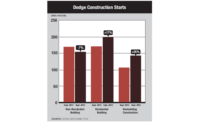Jobsite cameras take scheduled photos from static positions and stream them to private users or public websites, stringing together the images as movies of projects going up or to archive for later use. While the cameras are a hit with developers and marketers of high-end residential buildings and flagship projects, they are becoming a general construction staple, written into specs from the start, say users and vendors.
Sources also say the range of job-cam uses and paybacks is as broad as the roles of people accessing them.
Mark Penny, a senior vice president for the Dallas region of Manhattan Construction Inc., says his company, a large, self-performing general contractor, has used many vendors, although it most recently has turned to EarthCam. "We have a lot of high-profile jobs that people want to see. They are a great opportunity for us and the client to showcase the construction, which makes the job of selling what we do a lot easier," he notes.
Penny says the cameras can improve security, but "that's not the primary use." The photographic record also can verify that activities, such as concrete placement, are done on schedule. But, he says, "in the end, we have a time-lapse video that's just a great wrap-up marketing piece."
Penny says Manhattan doesn't use job cams for safety monitoring, either. "We have on-site safety guys. If we are doing that on a webcam, we may feel we are missing the mark," Penny says.
However, Warren Andres, senior vice president at general contractor Andres Construction, also in Dallas, which uses many subcontractors, is far more hands-on with his job cams. He prefers ePlanit, a local vendor with whom he has had a long relationship. "It's awesome because it is totally mobile. It's cell-phone signals and solar panels on a trailer. Within hours, they can have it on the jobsite."
Andres says he has three monitors on his desk. One shows live feeds from all his cameras. If he sees unsafe work, he sends a photo to the superintendent and demands action. Similarly, he says he can spot slow work crews and do enough quality control to send the message that management is watching. "You can't see everything, but you can pan, tilt and zoom and count the screws on the sheathing."
With hour-and-a-half drive times to get across town, Andres says that, "with a camera, I can be there right now and in more places at once. Productivity goes up, and the value you get in one day sometimes pays for it all."
Jason Burns, vice president of technology at Hunter Roberts Construction Group,New York City, says he often recommends Hackensack, N.J.-based EarthCam to clients. But besides arranging jobsite placement and bringing together owners and vendors, he has little other involvement. "The PR value is for the owner," he says. "EarthCam is icing on the cake. It's nice to show jobs you have done, but it's not providing me much for construction. But [EarthCam] has the software and the know-how to build a job in a two-minute time lapse and make it look good. You're buying that."
Hardware and plans vary from low-resolution off-line cameras that store images for retrieval to ultra-high-resolution units that have big zoom lenses and internet-operable controls. Users can vary shot frequency and pan, tilt and zoom, or PTZ, at will. The images stream to websites and storage systems. Costs vary from a few hundred dollars a month to $30,000 or more per camera per job, depending on the level of sophistication and service.






Post a comment to this article
Report Abusive Comment